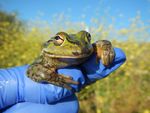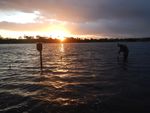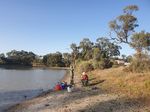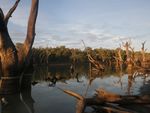THE BIDGEE BULLETIN - Environment.gov.au
←
→
Page content transcription
If your browser does not render page correctly, please read the page content below
JUNE 2020 ISSUE 4
THE BIDGEE BULLETIN
Quarterly Newsletter of the Murrumbidgee Monitoring Program
RESEARCH PROJECTS Welcome to Issue 4 of The Bidgee Bulletin. In
this issue we highlight two of the research
This issue we feature two research projects developed by projects that operate in conjunction with the
researchers from Charles Sturt University and partner Murrumbidgee Monitoring, Evaluation and
organisations that explore the relationships between Research (MER) Program. We also check in
environmental watering actions and biodiversity with CSU PhD researcher Anna Turner and get
responses in the Murrumbidgee region. The projects are an update on her work studying the prevalence
a baseline vegetation assessment (benchmarking) of chytrid fungus in southern bell frogs in the
project, and a study of the importance of artificial lower Murrumbidgee region. And in this issues
wetlands (such as farm dams) for frogs. 'Who's Who in the Zoo' we feature Madeline
Gorham, one of our colleagues from the
VEGETATION BENCHMARKING Commonwealth Environmental Water Office.
Regular flooding is vital to maintain healthy river red gum
forests and black box woodlands. Flood regimes The Bidgee Bulletin is a quarterly newsletter
determine the types of vegetation communities that grow designed to provide updates on our progress as
in different wetlands. Permanent wetlands and those we monitor the ecological outcomes of
which regularly receive water are often characterised by Commonwealth environmental water flows in the
large expanses of open water fringed by river red gum Murrumbidgee Selected Area. The 2019-2022
trees. Shallow wetlands that are seasonally inundated program builds on the previous five year
are often dominated by spike rush and the common reed. monitoring period (2014-2019) and uses many
Wetlands that rarely become inundated, except during of the same methods.
natural flood events, may experience dense river red
gum regeneration that results in saplings encroaching on
the wetland.Some wetlands in the mid-Murrumbidgee region such as McKenna’s Lagoon
have experienced high densities of river red gum recruitment, with trees
growing throughout the wetland and resulting in a reduction in wetland health
and function. CSU researchers are systematically benchmarking wetland
vegetation diversity and structure to assess the health of wetland vegetation
communities and the extent of red gum encroachment across the mid-
Murrumbidgee and Lowbidgee regions. This information will help guide
targeted delivery of environmental water which has been shown to maintain
areas of open water and improve vegetation diversity.
From top: River red gum encroachment at
McKenna's Lagoon in the mid-Murrumbidgee;
barking marsh frog; Yanco billabong FROGS IN FARM DAMS
The majority of frog species found along the Murrumbidgee River require
slow-moving or still water to breed. As many natural wetlands no longer
receive regular water, many frog species have declined and populations of
the threatened southern bell frog are now dependent on environmental water
or artificial wetlands such as irrigation channels and farm dams. During the
spring and summer drought of 2019-2020, CSU researchers in partnership
with YACTAC (Yanco Creek and Tributaries Advisory Council) surveyed frogs
in 42 sites along Yanco Creek. Surveyed sites included both farm
infrastructure (farm dams and irrigation channels) and natural wetlands such
as billabongs and creeks. Preliminary findings from the surveys indicate that
six frog species were calling and using these habitats, including ground-
dwelling species such as the spotted marsh frog, barking marsh frog and
plain’s froglet; burrowing species such as the inland banjo frog; tree-dwelling
species such as Peron’s tree frog; and the southern bell frog. Many species
were recorded from farm dams highlighting the value of this type of habitat as
a refuge for frogs during times of drought.
In March, the Murrumbidgee Environmental Water Advisory Group (EWAG)
meeting took place in Leeton. The following morning participants visited
several wetland sites including Gooragool Lagoon where CSU researcher Dr
Damian Michael explained the use of artificial bark covers to survey for tree-
dwelling reptiles and invertebrates.
The group is made up of community representatives, stakeholder groups and
government departments. It provides a point of interface between the
community and the Commonwealth and State governments and is an
opportunity for high-level involvement in the management of water for the
environment in the Murrumbidgee catchment.
Below: Grey snake (photo: Damian Michael). Detection of the little known grey snake around Lowbidgee wetlands is the
subject of a new journal article published recently in Australian Zoologist. The
snake was observed and identified by MER Program researcher Dr Damian
Michael during routine wetland monitoring activities over Summer 2018-19.
This was the first confirmed sighting of this species south of the
Murrumbidgee River, representing a southern range extension and
confirmation that the species still persists in south-western NSW. Improved
awareness of this small noctural snake has seen us detect more individuals
at key Lowbidgee wetlands during 2019-20 field monitoring activities.
Find the article at: https://publications.rzsnsw.org.au/doi/10.7882/AZ.2020.008IT'S NOT EASY, BEING GREEN
Charles Sturt University PhD student Anna Turner has been a frequent visitor
to the wetlands of the Lowbidgee over the past couple of years. Since
September 2018 she's spent hundreds of hours searching for populations of the
threatened southern bell frog in the region. Anna's research is focused on
amphibian chytrid fungus in southern bell frogs and the effect of environmental
conditions, particularly temperature, on disease prevalence.
Her time in the field has involved capturing 1200 frogs, including over 500
southern bell frogs. She's been recording data including frog size, weight, body
temperature, sex, activity, distance to water and location, and has collected
skin swabs which are sent off to a laboratory to be analysed to determine if any
of the tested frogs are infected with the chytrid fungus and if so, what level of
infection they have.
Chytrid fungus is an aquatic fungus which lives on the frog’s skin and
consumes keratin in the skin cells causing a disease called chytridiomycosis.
The disease affects the frogs’ skin which can disrupt respiration and heart
function, and eventually lead to cardiac arrest and death. Since its discovery in
1998, chytrid has been detected in more than 500 amphibian species and
occurs in at least 52 different countries. In Australia, 62 out of 242 native frog
species have been detected with the chytrid fungus. As the fungus is sensitive
to temperature, the impacts on frog populations have largely occurred in cooler
regions and at higher altitudes. Little study has been done outside the
predicted temperature range of the fungus.
Last season (2018-19) Anna found low levels of chytrid infection in frogs
swabbed from the lower Murrumbidgee region. There was low prevalence and
low infection intensity, however it is present. This project is investigating how
chytrid fungus is able to survive in these regions which are predicted to be
outside its usual range due to environmental conditions. Anna has temperature
loggers deployed in wetlands which have been measuring water surface
temperature in a number of different vegetation types and depths. Using these
loggers she hopes to map out the temperature regimes of the wetlands and
gain a better understanding of where this fungus is able to persist and how
timing of watering events may influence infection prevalence and mitigate its
spread.
From top: southern bell frog; Anna Turner
collecting a skin swab; volunteer Matilda Terry
New Website Reveals Science Behind
measuring water quality; volunteer Chi Wei
spotlighting for frogs in the lignum at Eulimbah Environmental Flows
Swamp.
Murray-Darling Basin communities can now access the science behind
environmental water with the launch of the new Flow-MER website. The
website brings together the work of independent scientists from some of
Australia’s leading regional universities and research institutions on how
Commonwealth environmental water is making a difference to the Basin’s
rivers, wetlands and floodplains. Monitoring, evaluation and research are
central to how Commonwealth water is managed to improve the health of our
rivers.
“The Flow-MER website is a great step towards improving transparency of our
decision making. It offers people a way to engage with the scientists and seefor themselves the thinking behind when and where we deliver water for the
environment,” said Jody Swirepik, Commonwealth Environmental Water Holder.
"Flow-MER builds on ten years of robust scientific monitoring and research that
underpins our understanding of how plants and animals respond to water for the
environment. By keeping decision makers abreast of the latest scientific findings,
we can ensure that water for the environment is used in the best way possible to
support fish, waterbirds, and wetlands,” said Dr Carmel Pollino, Principal
Research Scientist at CSIRO.
Numerous scientists work out in the field at locations across the Murray-Darling
Basin, often with the involvement of Traditional Owners, local water managers
and landholders.
“No matter where you live in the Basin, you can look at the Flow-MER website to
find out where scientists are monitoring environmental flows near you. There are
plenty of great photos and some terrific stories about the frogs and turtles that
we meet when we are out in the field,” said Skye Wassens, Principal Scientist,
Charles Sturt University.
The Flow-MER website is now online. Visit flow-mer.com.au
Gayini Nimmie-Caira - return to
traditional custodians
Gayini Nimmie-Caira, an 84,417 hectare property of internationally significant
Murrumbidgee floodplain and wetlands, was offically handed back to its
Traditional Custodians - the Nari Nari people, on 20th March 2020.
Originally purchased under an agreement between the Australian and New South
Wales governments to contribute to achieving Murray-Darling Basin Plan
outcomes, 19 separate properties were merged to form what is now known as
Gayini Nimmie-Caira. Since May 2018 the property has been managed by a
consortium led by The Nature Conservancy and including the Nari Nari Tribal
Council, the Murray Darling Wetlands Working Group and the Centre for
Ecosystem Science at the University of NSW.The property contains large areas of open lignum floodplain and floodways, and is
home to a stunning variety of native Australian birds ranging from tiny spotted
pardalotes to stately emus. When conditions are favourable extensive wetlands
provide feeding and breeding habitat for many different species of waterbirds
which can form large nesting colonies. The wetlands also support a range of
threatened species including significant populations of the southern bell frog. It's
part of the Lowbidgee floodplain, which is the largest area of intact wetlands
remaining in the Murrumbidgee Valley and an area of national and international
conservation significance.
Known as 'Gayini', the Nari Nari word for water, the area has been managed by its
Traditional Custodians for over 50,000 years and is rich in Indigenous cultural
sites, including scar trees, burial mounds and camp sites. Since being back
managing Country, the Nari Nari are using a combination of traditional and modern
methods to assess, protect and restore the landscape - removing feral animals,
reinstating a natural inundation regime, identifying and protecting cultural sites and
repairing infrastructure.
The director of The Nature Conservancy in Australia, Rich Gilmore, said: “Gayini is
now legally owned by the Nari-Nari people, as it has been spiritually for 50,000
years". The property will continue to be managed for the protection and restoration
of Indigenous culture and heritage, conservation values and sustainable economic
From top: Telephone Creek; kangaroo near development. The MER Program monitors several wetlands within Gayini Nimmie-
Eulimbah Swamp; processing at Avalon Caira and welcomes the handover back to the Traditional Custodians.
Dam, Gayini Nimmie-Caira.
Map showing monitored wetlands within the three Murrumbidgee zones:
Redbank, Gayini Nimmie-Caira and the mid-Murrumbidgee.WHO'S WHO IN THE ZOO?
This issue we find out a little more about one of our colleagues from the
Commonwealth Environmental Water Office …
Name: Madeline Gorham
Organisation: Commonwealth Environmental Water Office
Position: Water manager
I studied at: Red Bend Catholic College in Forbes, then University of Canberra
to study Landscape Architecture/Environmental Science, then later at Charles
Sturt University for a Honours degree in Environmental Science &
Management.
In my previous jobs I: wrote policy for the Basin Plan and then worked with
landholders to achieve on-ground landcare initiatives
Food attitude: sweet
Beverage of choice: beer
How would you describe your work to a child?
I help rivers run and the things that live in the river, like fish.
What’s the best thing about your work?
variety
Your work in three words?
Water, Challenging, Political
Is your career your parents fault?
Yes probably. My Dad was a lucerne and sheep farmer on the Lachlan River
and my Mum works as a water licenser.
It’s now 2030, where are you?
Still working on the Bidgee
The Murrumbidgee MER team would like to Flashback to 1999 – where were you then?
acknowledge the consortium partners and local Bedgerabong Public School
landholders with whom we work. Given the chance, who would you like to be for a day?
Annabel Crabb - an expert juggler
What’s your favourite sign off?
Cheers
We respectfully acknowledge the Wiradjuri,
Nari Nari and Muthi Muthi peoples,
traditional owners of the lands on which this
publication is focusedYou can also read



























































